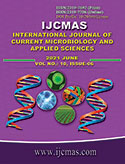


 National Academy of Agricultural Sciences (NAAS)
National Academy of Agricultural Sciences (NAAS)

|
PRINT ISSN : 2319-7692
Online ISSN : 2319-7706 Issues : 12 per year Publisher : Excellent Publishers Email : editorijcmas@gmail.com / submit@ijcmas.com Editor-in-chief: Dr.M.Prakash Index Copernicus ICV 2018: 95.39 NAAS RATING 2020: 5.38 |
Adverse event following immunization (AEFI) is basically an event of unexpected medical emergency occurring after vaccination on immunization without any causal association with vaccination. It can be any unintended, abnormal laboratory finding or anything. At the time of vaccination, there are many reasons like improper way of vaccination by health worker or quality defect of any specific vaccine. All these are the unintentional events which can lead to an adverse event in any individual. As recognition of adverse events resulted due to vaccine can be both before and after licensure. Before includes vaccination on candidate trials for evaluation of efficacy and protection. These trials mainly included various individual and can identify frequent adverse events involved after vaccination. Although, adverse events which are very rare cannot be observed during pre-licensure testing and can only be observed at the time of marketing surveillance when it come in use at wide scale. Post-marketing surveillance became complex due to the events resulting after vaccination are not mainly caused through administration of vaccine. Establishment of AEFI resulting due to any vaccination program requires careful assessment of few factors like laboratory handling, clinical factors and epidemiological factors. Its cause and effect can be enhanced by determination of rate of illness following immunization which is greater than illness in absence of vaccination. Consequently, significant attention must be required for interpreting adverse event reports associated temporarily with causality of vaccination. Currently, two complementary post-marketing system of surveillance for vaccines in United States are present. In 1978, a monitoring system was established for adverse event following immunization (AEFI) for collecting reports for public sector concerning adverse events following immunization. These reports were made from the data collected from the person who is vaccinated within 30 days of receiving vaccine. There had been some specific knowledge associated with vaccination and its adverse events like anaphylaxis associated with hepatitis B, measles thrombocytopenia and various other vaccines associated adverse events were observed which are normal but in few cases, anaphylaxis and spread of disease in immunocompromised individuals can lead to death. So, at the time of vaccination, care should be taken in assessing individuals medical history.
 |
 |
 |
 |
 |